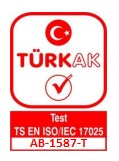Low Pressure (Altitude) Test

MIL-STD-810 F/G/H — RTCA DO 160 G
Low Pressure (Altitude) Testing is designed to test the performance, reliability and durability of the sample at low atmospheric pressures. It describes a test method to be applied to determine whether a material will perform in a low-pressure environment or whether it will withstand rapid pressure changes.
As STEST, it operates an altitude test chamber capable of simulating altitudes up to 70,000 feet while providing temperature conditioning from -54 to +80 degrees Celsius. Special setups for altitude, rapid and explosive decompression testing are standard procedures.
Low Pressure (Altitude) Testing is performed to ensure that the equipment can withstand and operate in a low pressure test or high altitude test environment. Altitude testing, equipment designed for airborne transportation of material on an aircraft, installation at high ground altitudes, and uçak Designed to be used for explosive decompression due to damage. Manufacturers of any airborne device must consider the impact of high altitude testing or low pressure testing on their products.
The MIL-STD-810G Method 500.5 standard includes four procedures: air transport storage, air transport operating, rapid decompression, and explosive decompression. In this context, depending on the intended use, low temperature tests are also applied at high altitudes. At higher altitudes the ambient temperature is generally much lower than in a testing laboratory. This lower temperature for a computer to operate can be advantageous in cooling. For many materials and equipment, a test time of at least one hour is considered sufficient.
During Low Pressure / High Altitude Test; There should be no air inlet/exit between our High Altitude Test Cabin and the environment. To ensure functional tests during the test; In order to prevent air entry/exit, all distributions (communication, power cables, etc.) of the sample to be tested are removed to the laboratory environment through hermetic passage through the side ports of our High Altitude Test Cabin.
Standards and Methods
- MIL-STD-810F Method 500.4
- MIL-STD-810G Method 500.5
- MIL-STD-810H Method 500.6
Enviromental Test Chamber Specifications
|
|
Altitude Cabin |
Measurement unit |
|
Chamber Length |
2000 |
mm |
|
Chamber Diameter |
1400 |
mm |
|
Minimum Temperature |
-54 |
°C |
|
Maximum Temperature |
+80 |
°C |
|
Altitude Altitude |
0-70000 |
Feet |
CONTACT BY EMAIL
[email protected]
VOICE COMMUNICATION
+90 (312) 905 06 90

STANDART KONTROL VE TEST HİZMETLERİ A.Ş.

